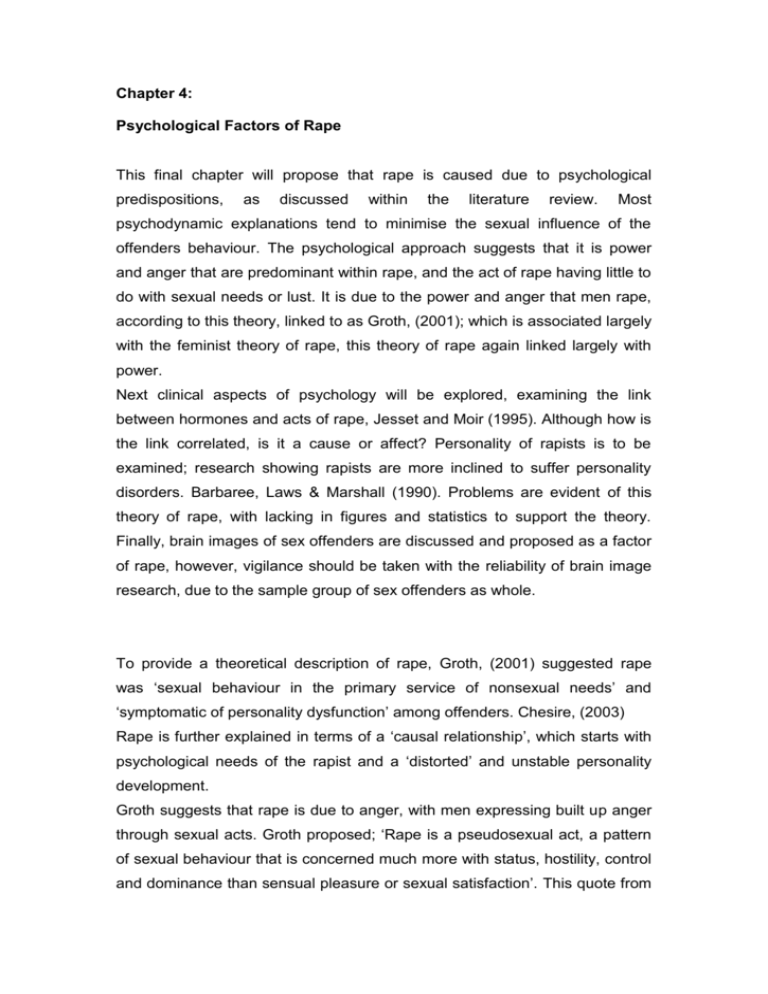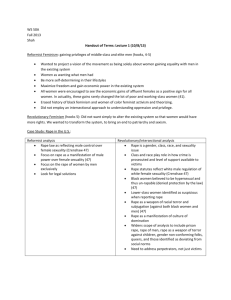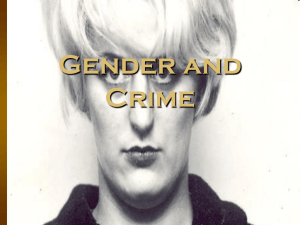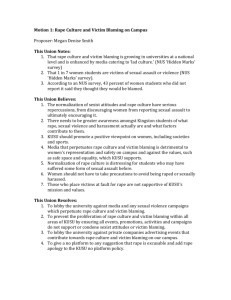
Chapter 4:
Psychological Factors of Rape
This final chapter will propose that rape is caused due to psychological
predispositions,
as
discussed
within
the
literature
review.
Most
psychodynamic explanations tend to minimise the sexual influence of the
offenders behaviour. The psychological approach suggests that it is power
and anger that are predominant within rape, and the act of rape having little to
do with sexual needs or lust. It is due to the power and anger that men rape,
according to this theory, linked to as Groth, (2001); which is associated largely
with the feminist theory of rape, this theory of rape again linked largely with
power.
Next clinical aspects of psychology will be explored, examining the link
between hormones and acts of rape, Jesset and Moir (1995). Although how is
the link correlated, is it a cause or affect? Personality of rapists is to be
examined; research showing rapists are more inclined to suffer personality
disorders. Barbaree, Laws & Marshall (1990). Problems are evident of this
theory of rape, with lacking in figures and statistics to support the theory.
Finally, brain images of sex offenders are discussed and proposed as a factor
of rape, however, vigilance should be taken with the reliability of brain image
research, due to the sample group of sex offenders as whole.
To provide a theoretical description of rape, Groth, (2001) suggested rape
was ‘sexual behaviour in the primary service of nonsexual needs’ and
‘symptomatic of personality dysfunction’ among offenders. Chesire, (2003)
Rape is further explained in terms of a ‘causal relationship’, which starts with
psychological needs of the rapist and a ‘distorted’ and unstable personality
development.
Groth suggests that rape is due to anger, with men expressing built up anger
through sexual acts. Groth proposed; ‘Rape is a pseudosexual act, a pattern
of sexual behaviour that is concerned much more with status, hostility, control
and dominance than sensual pleasure or sexual satisfaction’. This quote from
Groth presents the basis of psychological explanations of rape, With sexuality
having little to do with the rape, as Groth (2001) explains, by the majority of all
rape acts reported showing a unnecessary amount of force used, which
according to this theory of rape, demonstrates the anger present within the
act.
Groth suggests that rape is caused by built up anger, and for this reason, it
takes time for his frustration to reach a dangerous unstable point, with his
‘extent to hurt and degrade the victim, his weapon sex, and his motive
revenge’ Groth, (2001) 17. With the revenge a rapist being discussed by
Jesset and Moir (1995) who maintain that revenge rape has little to do with
the victim, but more to do with women in general, or to even get even with a
victims male partner, linking in with the feminist approach of the victim being
the mans property, with revenge rapists thieving another mans property.
Groth also claims that power is commonly linked to rapists, thus rape is
explained by the dominance feel that motivates the offender to carry out these
acts, with the offender wishing to control the victims sexually. The power
rapist aims to capture, conquer and control his victim, with sexual desire not
being the primary aim of the rape act.
Rape can be seen as a sex commodity, to where women are perceived as
objects, (links prominent with the feminist account of rape also) rape enabling
men to have power to do as they wish, without having to worry about pleasing
partners, and being selfish to their own sexual and psychological needs.
Jesset and Moir (1995)
Most power rapist’s intention is not to harm the victim in any way, but to
possess her sexually; however, physical aggression is reported to be used to
‘overpower the victim. Most offenders feel insecure about their masculinity,
and in conflict with their identity, (sometimes sexual, as the personality
component of rape explains, with many rapists having sexuality worries).
Rape is therefore a method of proving heterosexuality, Groth, (2001)
Groths work provides a significant contribution in understanding the dynamics
of the psychological theory of rape. However, as mentioned within chapter
two, Groth is criticised for his sample used, and its inability to be generalised.
Despite the fact that Groths sample is large, it is yet still limited to rapes that
were reported, (with it being estimated that only 2% -5% ever being convicted)
and also the most dangerous of rapists, to whom were sent to special
treatment centres. Allison & Wrightsman, (1993)
Prentky and Knight (1991) provide details of the different types of rapist; the
Power Reassurance rapist, the Power Assertive rapist, the Anger Retaliatory
rapist, and the Anger Excitation rapist. These apparent four different types of
rapist could offer support Groth (2001) and his theory of rape, of anger and
power.
The Power Reassurance rapist typically uses non violent behaviour
throughout the attack, which in turn makes the offender believe his behaviour
is acceptable, and restores any doubts that offender have, about women
perceiving them as undesirable, due to the act seeming normal.
The Power-Assertive rapist is aggressive within his actions, but doesn’t assert
lethal behaviour, this in turn reimbursing power assertive rapists self doubts
and fears.
Anger-Retaliatory rapists use extreme levels of physical force and sexual
aggression within their attacks. Similar to this is the Anger-Excitation offender,
where aggression is used to cause pain and suffering to provide the offender
with sexual gratification.
Although the work of Prentky and Knight (1991) goes into much depth about
the various types of rapist, it is questionable as whether all offenders can fit
into a ‘criteria’ of certain types of rapists, as with all individuals, every offender
has individual differences, and to try and categorise people surely has
dangerous consequences with potential victims.
Categorizing rapists is a useful starting point in the development of treatment
programs for offenders, although more work should be contemplated to
prevent rapes, thus examining known characteristics and personalities of
convicted rapists, to perhaps work directly with the health authorities and
psychologists to become aware of these at risk signs, and use appropriate
referrals. The hormonal pathways of rapists will be considered.
In terms of the psychology of the brain, research has suggested that rapists
have certain dysfunctions within their brain, hormones or neural pathways.
Jesset and Moir (1995), it is these dysfunctions that according to theoretical
psychological why men become sexually deviant and commit rape.
Ellis, cited in Jefferson & Grover (1993) suggests through research findings
that rapists generally have higher hormone levels, of androgens, which are
known to increase sex drives and also minimise threats of punishment, and
sensitivity of others feelings; this work by Eliis, compared to non rapists.
Although, hormonal diversity within the brain is able to explain some of the
variance in aggressive sexual behaviour, in general these explanations are
unable to explain how much of the variance is due to sexually aggressive
behaviour. Jefferson & Grover (1993)
Rape cannot therefore be ascribed to a single chemical hormone, due to the
multiplicity of different rapes; as stated in chapter three. In regards to power
dominance as a explanation of why men rape, (Millet 1969), and also with
Groths (2001) research examining the two different power and anger rapes. It
is wrong to assume, that all rape is caused by one chemical hormone, as
research strongly suggests throughout this paper that rape is a complex act
with different kinds of rape, with it having little to do with sex.
However, problems are apparent with Ellis’ work, in the hormones presence;
cause or affect. It may well be that the brain dysfunction in the release of
hormones is not a cause of rape, but perhaps a by-product of sexual
activity/rape. Ellis’ research is capable of proving a relationship between
androgens and rape, yet, complications lie with trying to determine if the
hormones are a cause of rape, or an affect.
To overcome this problem, and gain a greater understanding of the hormone
link with rape, it could be suggested that more in depth research to be
conducted, examining levels of hormones, and when they are at the highest,
lowest etc.
With personality being a hugely important link between biological basis of the
brain and social environments, Millon, (1996), it is for that reason
personalities of offenders are quite rightly examined. Jesset and Moir (1995)
established that rapists have a ‘effeminate’ personality, that is they posses
qualities that are more associated with women, than men, as a result, their
sexuality is often open to question among others and the offender himself.
The work of Barbaree, Laws & Marshall (1990) shows that the majority of
convicted rapists within their study meet the diagnostic criteria for ‘so called’
personality disorders, these disorders including ‘sociopathic, schizoid,
paranoid and narcissistic personality disorders’ are all described.
With personality disorders involving an inability of human attachments and
social relationship, this linking in with the childhood factors chapter, of inability
to form relationships when younger.
Although problems appear, in the lack of statistics for the theoretical
perspective of personality and crime, there are little if any relevant figures, on
how many rape offenders have personality disorders. It was within the chapter
one, the literature review that it was recommended try and incorporate
statistics, to show how reliable this approach was.
Although explorations show have indicated that characteristics of the majority
of sex offenders, in terms of diagnostic points of view, is generally normal,
with little needing treatment, this perhaps, explaining why there is little
statistics on rape offenders. Barbaree, Laws & Marshall (1990),
However, if the majority are classed as ‘normal’ diagnostically, then surely an
offender’s personality would be unaffected.
For this reason, I feel that personality disorders are inadequate to explain
rape, and will now move onto brain imaging explaining rape.
Wrights et al, (cited in Raine, 1993) research into sex offenders, suggested a
link between sex offenders, (mainly rapists) and damage within the temporal
lobe. Of the studies conducted, there was great evidence for defects in the
temporal lobe. Wrights et at (cited in Raine, 1993) found further evidence of
the frontal lobe also being damaged among convicted rapists.
Dysfunction of the emotional control centres through abnormalities in the
internal nerve networks, can often lead to the inappropriate sexual arousal,
this in conjunction with wrong cues learnt from parents within childhood,
leading to sexual deviancy. This proposed by Jesset and Moir (1995), and
support for the brain imaging factor of rape.
Although with both the research studies regarding personality by Wrights et al
and Jesset and Moir, sampling of the group are concerning. Both the studies
including sex offenders in general, ranging from ranging from paedophiles,
sadistic sexual assaulters, incest offenders, violent offenders and rapists. For
this reason, therefore, how much can the research on personality be
generalised to rapists? As only proportion of the sample are rapists, with the
research not indicating the actual figure. Implications for future studies, to
ensure greater validity of such personality theoretical perspectives of rape,
would be to base investigations solely on rape offenders. Due to this
observation, personality to explain rape, I feel is insufficient and lacking, as a
result to be overlooked to explain rape.
Biology
In summary, this final chapter has considered psychological theories of rape.
Firstly the anger and power approach reflected by Groth, (2001), whom
asserted there was two types of rapists; anger and power. Although Groths
work has been criticised for his sample group in that he only examined
convicted rapists, I still feel personally this is a convincing account of rape, as
it takes into account different types of rapes.
The chapter then examined the clinical aspects of rape; looking at hormones
of rape offenders, finding that sexually deviant men generally have higher
androgens levels than none sexually deviant men, However, it was
determined, that a single hormone isn’t able to explain the diversity of known
rapes. Also with the presence of androgen, it is being a cause, or effect of
rape.
Personality of sex offenders was also discussed, research illustrating that
many were described as having ‘clinical personality disorders’ although, there
being little documented literature of statistics of many rape offenders suffer
from this disorder, as a result this theory dismissed. Finally, the chapter then
turned to brain imaging of rape offenders, noting that a high proportion had
damage within their frontal and temporal lobes, and abnormalities in the
internal nerve networks. However, the research for these studies focused on
sex offenders as a whole, making it difficult to work out how much this
research can apply to rapists.
Bibliography:
Groth N, (2001) ‘Men Who Rape’ Psychodynamics of rape. Plenum Press.
New York.
Prentky and Knight (1991). Identifying critical dimensions for discriminating
among rapists. Journal of Consulting and Clinical Psychology, 59 (5), 643661.
Becker at al (2004) A preliminary study on findings of psychopathy and
affective disorders in adult sex offenders, International Journal of Law and
Psychiatry 28, (6) , Pages 637-649.
Millon , (1996) Disorders of personality: DSM-IV and beyond. , Wiley, New
York.
Chesire, (2003) ‘Review, critique, and synthesis of personality theory in
motivation to sexually assault’. Aggression and Violent Behaviour
Volume 9, (6),
Jesset and Moir (1995) ‘A Mind To Crime’ Michael Jospeh, London.
Jefferson & Grover (1993), ‘Sexual aggression: issues in etiology,
assessment, and treatment’ Taylor & Francis, Washington.
Allison, J & Wrightsman, L (1993) “Rape and the law” Rape, Sage
Publications, USA.
Barbaree, Laws & Marshall (1990), ‘Handbook of Sexual Assault’ Plenum
Press, New York.
Raine (1993) ‘The Psychopathology Of Crime’, Academic Press, London.








